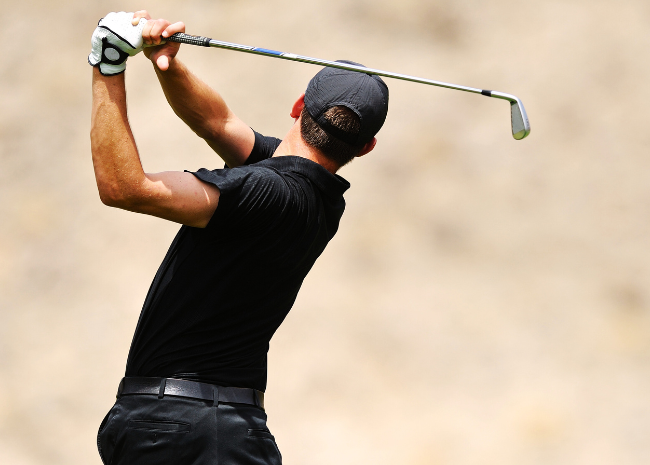
Is Your Elbow Pain a Pain in the Neck?
What is Golfer’s Elbow?
Golfer’s or pitcher’s elbow, also called medial epicondylitis, causes pain on the inner side of the elbow, and weakness and tingling in the forearm and hand. However, the condition is not limited to athletes.
In fact, it’s actually more common in people who:
- Smoke
- Operate vibrating equipment
- Engage in manual labor, especially if lifting more than 25 pounds
Symptoms of Golfer’s Elbow
- Pain on the Inner Elbow: The most common symptom is a dull or sharp pain on the inside of the elbow. This pain may also radiate down the forearm.
- Tenderness: The inner side of the elbow becomes tender to the touch. This tenderness is often felt around the bony bump on the inside of the elbow, known as the medial epicondyle.
- Weakness in the Forearm: You might notice a decrease in strength in the forearm, making it difficult to perform tasks that require gripping or lifting.
- Difficulty Gripping Objects: Activities that involve gripping or holding objects, like shaking hands or lifting weights, may become challenging and painful.
- Swelling: In some cases, there may be mild swelling around the elbow, although this is less common than pain and tenderness.
- Pain with Wrist Movements: The pain often worsens with wrist movements, especially those involving bending the wrist or fingers. For example, swinging a golf club or racket can exacerbate the discomfort.
- Stiffness: The elbow may feel stiff, particularly in the morning or after periods of inactivity, affecting the range of motion.
These symptoms can vary in intensity and may worsen with repetitive activities or prolonged use of the arm.
Could Elbow Pain be a Pinched Nerve?
Here’s a twist: for many of these individuals, elbow pain can be related to a pinched nerve in the neck, technically called cervical radiculopathy.
Let’s dive into how this works.
Anatomy of the Cervical Spine
The cervical spine, or neck, is made up of seven vertebrae separated by flexible disks.
These seven cervical (neck) vertebrae are separated by tough, flexible disks that absorb shock from movement. Each have a large hole in the center through which the spinal cord passes and several smaller holes that allow nerves coming off the spinal cord to enter the body.
When a nerve root gets injured at the point where it exits the spinal column, it’s called radiculopathy.
What Causes Cervical Radiculopathy?
In younger people, radiculopathy usually results from a herniated or bulging disk that causes pain by pressing on the nerve root. In older people, the cause is often a change in bone structure that narrows the hole through which the nerve passes.
When Golfer’s Elbow and Cervical Radiculopathy Overlap
Sometimes, the pain from golfer’s elbow might actually be referred pain from cervical radiculopathy.
This means that a problem in your neck could be causing symptoms in your elbow. This link can sometimes lead to misdiagnosis or less effective treatments if not considered.
Diagnosing Golfer’s Elbow
When it comes to diagnosing golfer’s elbow, it involves a few steps:
- Physical Examination: Your healthcare provider will check for pain, tenderness, swelling, and assess your range of motion.
- Medical History: Detailing any previous injuries or activities that might have contributed to your condition is important.
- Imaging Tests: While X-rays are used to rule out fractures, they don’t show soft tissue issues. Ultrasound and MRI scans are better for visualizing tendons and muscles to spot inflammation or tears.
Treatment Options for Golfer’s Elbow
Here’s what you can do if you’re dealing with golfer’s elbow.
Treatment:
- Rest and Ice: Rest the affected arm and apply ice packs for 15-20 minutes several times a day to reduce inflammation.
- Physical Therapy: Engaging in physical therapy can be incredibly beneficial. Exercises might include wrist curls, forearm pronation and supination, and eccentric strengthening exercises.
- Manual Therapy and Ultrasound: Techniques like manual therapy and ultrasound can also be effective in treating golfer’s elbow.
- Surgery: In severe cases where conservative treatments don’t work, surgery might be needed to remove damaged tissue or repair tendons. This is usually a last resort.
Improving Posture and Alignment
If your neck is the root cause of your elbow pain, correcting your posture can help.
In addition to creating a customized exercise plan, physical therapists can help you improve your posture and alignment.
At The Jackson Clinics, our physical therapists can assist with:
- Proper Spine Alignment: Whether at home or work, ensuring good posture can make a big difference.
- Stabilizing Muscles: Using muscles like the serratus anterior, middle and lower trapezius, rhomboids, and latissimus dorsi can help.
- Cervical Retraction Technique: An easily learned technique called cervical retraction can be performed at home 20 to 30 times each day. This can be done all at once or more often divided into five to eight repetitions four to five times during the day.
Ready to find relief from golfer’s elbow?
Check out our 18 Northern Virginia locations to book an appointment with one of our physical therapists and get started today.
Working with Your Physician
For ultimate success in treating your cervical radiculopathy and elbow pain, you can work together with your physical therapist and physician to design an exercise program of stretching and strengthening to help ease your pain and restore your function.
Contact Us for Help
If you’re struggling with symptoms of golfer’s elbow or cervical radiculopathy, don’t hesitate to reach out.
At The Jackson Clinics, our experienced team can help with a comprehensive treatment plan to get you back to doing what you love—pain-free.
Did you know you have Direct Access* to Physical Therapy? No referral, no problem!
















